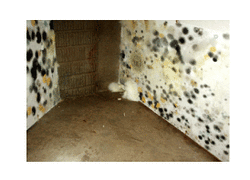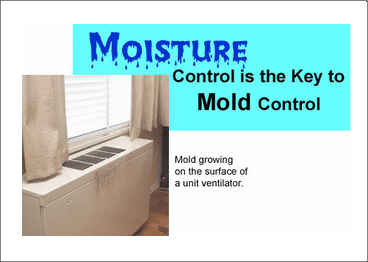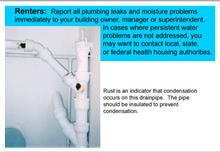Ten Things You Should Know About Mold
1. Exposure to mold exposure can cause health related conditions such as allergic reactions, asthma, and other respiratory symptoms and complaints.
2. Controlling moisture is the most effective way to control and decrease the growth of mold. There is no practical way to eliminate all mold and mold spores in the indoor environment.
3. If you find mold in your home, you must clean the mold and ensure that sources of moisture are eliminated.
4. Reduce indoor humidity (to 30% to 60%) to decrease mold growth by:
5. Clean and dry any damp or wet building materials and furnishings within 24 to 48 hours to prevent mold growth.
6. Fix any leaks or water issues in order to prevent mold growth.
7. Water and detergent can be used to clean mold off hard surfaces, make sure you allow the area to dry completely.
Absorbent materials that are moldy (such as carpeting and ceiling tiles) may need to be replaced.
8. Prevent condensation. Reduce the potential for condensation on cold surfaces (i.e., windows, piping, exterior walls, roof and floors) by adding insulation.
9. Do not install carpet In areas where there is a perpetual moisture problem.
10. If moisture is present, molds can be found almost anywhere and they can grow on virtually any substance. Mold can grow on wood, paper, carpet, and foods.
MOLD

We don’t typically think of mold as being hazardous to our health, but the
truth is, if it lives in your home, mold can cause serious problems. It’s a good idea to have your current or future home inspected for mold by a professional. This ensures that any issues with mold can be addressed before it causes a health problem for you or your family.
Mold Basics
Why is mold growing in my home?
Molds are part of the natural environment. Outdoors, molds play a part in nature by breaking down dead organic matter, such as fallen leaves and dead trees. But indoors, mold growth should be avoided. Molds reproduce by means of tiny spores; the spores are invisible to the naked eye and float through outdoor and indoor air. Mold may begin growing indoors when mold spores land on surfaces that are wet. There are many types of mold, and none of them will grow without water or moisture.
Can mold cause health problems?
Molds are usually not a problem indoors, unless mold spores land on a wet or damp spot and begin growing. Molds have the potential to cause health problems. Molds produce allergens (substances that can cause allergic reactions), irritants and, in some cases, potentially toxic substances (mycotoxins). Inhaling or touching mold or mold spores may cause allergic reactions in sensitive individuals. Allergic responses include hay fever-type symptoms, such as sneezing, runny nose, red eyes, and skin rash (dermatitis). Allergic reactions to mold are common and can be immediate or delayed reactions. Molds can also cause asthma attacks in people with asthma who are allergic to mold. In addition, mold exposure can irritate the eyes, skin, nose, throat and lungs of both mold-allergic and non-allergic people. Symptoms other than the allergic and irritant types are not commonly reported as a result of inhaling mold. Research on mold and health effects is ongoing. This article provides a brief overview; it does not describe all potential health effects related to mold exposure. For more detailed information, consult a health professional. You may also wish to consult your state or local health department.
Testing or Sampling for Mold
Is sampling for mold needed? In most cases, if visible mold growth is present, sampling is unnecessary. Since no EPA or other federal limits have been set for mold or mold spores, sampling cannot be used to check a building's compliance with federal mold standards. Surface sampling may be useful to determine if an area has been adequately cleaned or remediated. Sampling for mold should be conducted by professionals who have specific experience in designing mold sampling protocols, sampling methods, and interpreting results. Sample analysis should follow analytical methods recommended by the American Industrial Hygiene Association (AIHA), the American Conference of Governmental Industrial Hygienists (ACGIH), or other professional organizations.
truth is, if it lives in your home, mold can cause serious problems. It’s a good idea to have your current or future home inspected for mold by a professional. This ensures that any issues with mold can be addressed before it causes a health problem for you or your family.
Mold Basics
- Moisture control is the key to controlling mold.
- If you find mold in your home, you should clean up the mold promptly and fix the water problem.
- It is important to dry water-damaged areas and items within 24 to 48 hours to prevent mold growth.
Why is mold growing in my home?
Molds are part of the natural environment. Outdoors, molds play a part in nature by breaking down dead organic matter, such as fallen leaves and dead trees. But indoors, mold growth should be avoided. Molds reproduce by means of tiny spores; the spores are invisible to the naked eye and float through outdoor and indoor air. Mold may begin growing indoors when mold spores land on surfaces that are wet. There are many types of mold, and none of them will grow without water or moisture.
Can mold cause health problems?
Molds are usually not a problem indoors, unless mold spores land on a wet or damp spot and begin growing. Molds have the potential to cause health problems. Molds produce allergens (substances that can cause allergic reactions), irritants and, in some cases, potentially toxic substances (mycotoxins). Inhaling or touching mold or mold spores may cause allergic reactions in sensitive individuals. Allergic responses include hay fever-type symptoms, such as sneezing, runny nose, red eyes, and skin rash (dermatitis). Allergic reactions to mold are common and can be immediate or delayed reactions. Molds can also cause asthma attacks in people with asthma who are allergic to mold. In addition, mold exposure can irritate the eyes, skin, nose, throat and lungs of both mold-allergic and non-allergic people. Symptoms other than the allergic and irritant types are not commonly reported as a result of inhaling mold. Research on mold and health effects is ongoing. This article provides a brief overview; it does not describe all potential health effects related to mold exposure. For more detailed information, consult a health professional. You may also wish to consult your state or local health department.
Testing or Sampling for Mold
Is sampling for mold needed? In most cases, if visible mold growth is present, sampling is unnecessary. Since no EPA or other federal limits have been set for mold or mold spores, sampling cannot be used to check a building's compliance with federal mold standards. Surface sampling may be useful to determine if an area has been adequately cleaned or remediated. Sampling for mold should be conducted by professionals who have specific experience in designing mold sampling protocols, sampling methods, and interpreting results. Sample analysis should follow analytical methods recommended by the American Industrial Hygiene Association (AIHA), the American Conference of Governmental Industrial Hygienists (ACGIH), or other professional organizations.
How to prevent mold growth in your home

Moisture and Mold Prevention and Control Tips
Actions that will help to reduce humidity:
Actions that will help prevent condensation:
- Moisture control is the key to mold control, so when water leaks or spills occur indoors, ACT QUICKLY. If wet or damp materials or areas are dried within 24 to 48 hours after a leak or spill happens, in most cases, mold will not grow.
- Clean and repair roof gutters regularly.
- Make sure the ground slopes away from the building's foundation so that water does not enter or collect around the foundation.
- Keep air-conditioning drip pans clean and the drain lines unobstructed and flowing properly.
- Keep indoor humidity low. If possible, keep indoor humidity below 60% relative humidity (ideally, between 30% to 50%). Relative humidity can be measured with a moisture or humidity meter, which is a small, inexpensive instrument (from $10 to $50) that is available at many hardware stores.
- If you see condensation or moisture collecting on windows, walls or pipes, ACT QUICKLY to dry the wet surface and reduce the moisture/water source. Condensation can be a sign of high humidity.
Actions that will help to reduce humidity:
- Vent appliances that produce moisture, such as clothes dryers, stoves, and kerosene heaters, to the outdoors, where possible. (Combustion appliances, such as stoves and kerosene heaters, produce water vapor and will increase the humidity unless vented to the outside.)
- Use air conditioners and/or de-humidifiers when needed.
- Run the bathroom fan or open the window when showering. Use exhaust fans or open windows whenever cooking, running the dishwasher or dishwashing, etc.
Actions that will help prevent condensation:
- Reduce the humidity (see above).
- Increase ventilation and air movement by opening doors and/or windows, when practical. Use fans as needed.
- Cover cold surfaces, such as cold water pipes, with insulation.
- Increase air temperature.

Testing or Sampling for Mold
Is sampling for mold needed? In most cases, if visible mold growth is present, sampling is unnecessary. Since no EPA or other federal limits have been set for mold or mold spores, sampling cannot be used to check a building's compliance with federal mold standards. Surface sampling may be useful to determine if an area has been adequately cleaned or remediated. Sampling for mold should be conducted by professionals who have specific experience in designing mold sampling protocols, sampling methods, and interpreting results. Sample analysis should follow analytical methods recommended by the American Industrial Hygiene Association (AIHA), the American Conference of Governmental Industrial Hygienists (ACGIH), or other professional organizations.
Suspicion of Hidden Mold
You may suspect hidden mold if a building smells moldy but you cannot see the source, or if you know there has been water damage and residents are reporting health problems. Mold may be hidden in places such as the backside of dry wall, wallpaper or paneling, the top-side of ceiling tiles, or the underside of carpets and pads, etc. Other possible locations of hidden mold include areas inside walls around pipes (with leaking or condensing pipes), the surface of walls behind furniture (where condensation forms), inside ductwork, and in roof materials above ceiling tiles (due to roof leaks or insufficient insulation).
Investigating Hidden Mold Problems
Investigating hidden mold problems may be difficult and will require caution when the investigation involves disturbing potential sites of mold growth. For example, removal of wallpaper can lead to a massive release of spores if there is mold growing on the underside of the paper. If you believe that you may have a hidden mold problem, consider hiring an experienced professional.
Cleanup and Biocides
Biocides are substances that can destroy living organisms. The use of a chemical or biocide that kills organisms such as mold (chlorine bleach, for example) is not recommended as a routine practice during mold cleanup. There may be instances, however, when professional judgment may indicate its use (for example, when immune-compromised individuals are present). In most cases, it is not possible or desirable to sterilize an area; a background level of mold spores will remain, and these spores will not grow if the moisture problem has been resolved. If you choose to use disinfectants or biocides, always ventilate the area and exhaust the air to the outdoors. Never mix chlorine bleach with other cleaning solutions or detergents that contain ammonia because toxic fumes could be produced.
Please note: Dead mold may still cause allergic reactions in some people, so it is not enough to simply kill the mold; it must also be removed.
Is sampling for mold needed? In most cases, if visible mold growth is present, sampling is unnecessary. Since no EPA or other federal limits have been set for mold or mold spores, sampling cannot be used to check a building's compliance with federal mold standards. Surface sampling may be useful to determine if an area has been adequately cleaned or remediated. Sampling for mold should be conducted by professionals who have specific experience in designing mold sampling protocols, sampling methods, and interpreting results. Sample analysis should follow analytical methods recommended by the American Industrial Hygiene Association (AIHA), the American Conference of Governmental Industrial Hygienists (ACGIH), or other professional organizations.
Suspicion of Hidden Mold
You may suspect hidden mold if a building smells moldy but you cannot see the source, or if you know there has been water damage and residents are reporting health problems. Mold may be hidden in places such as the backside of dry wall, wallpaper or paneling, the top-side of ceiling tiles, or the underside of carpets and pads, etc. Other possible locations of hidden mold include areas inside walls around pipes (with leaking or condensing pipes), the surface of walls behind furniture (where condensation forms), inside ductwork, and in roof materials above ceiling tiles (due to roof leaks or insufficient insulation).
Investigating Hidden Mold Problems
Investigating hidden mold problems may be difficult and will require caution when the investigation involves disturbing potential sites of mold growth. For example, removal of wallpaper can lead to a massive release of spores if there is mold growing on the underside of the paper. If you believe that you may have a hidden mold problem, consider hiring an experienced professional.
Cleanup and Biocides
Biocides are substances that can destroy living organisms. The use of a chemical or biocide that kills organisms such as mold (chlorine bleach, for example) is not recommended as a routine practice during mold cleanup. There may be instances, however, when professional judgment may indicate its use (for example, when immune-compromised individuals are present). In most cases, it is not possible or desirable to sterilize an area; a background level of mold spores will remain, and these spores will not grow if the moisture problem has been resolved. If you choose to use disinfectants or biocides, always ventilate the area and exhaust the air to the outdoors. Never mix chlorine bleach with other cleaning solutions or detergents that contain ammonia because toxic fumes could be produced.
Please note: Dead mold may still cause allergic reactions in some people, so it is not enough to simply kill the mold; it must also be removed.

